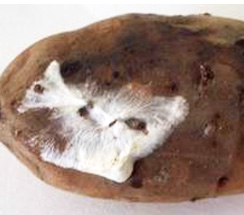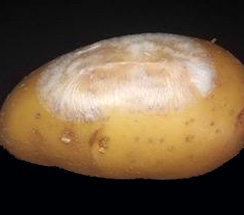| Post-harvest tuber rots: Sclerotium rolfsii |
Symptom:
- Wilting is the initial symptom.
- Yellowish brown coloured Sclerotia appeared on the infected tuber.
- Rotting of the tuber.
- Milky white and floccose appearance of the tuber.
|
| |
 |
 |
 |
 |
| |
Initial white fungal growth |
Fungal mycelium |
Roots with mycelium |
infected tuber |
|
Identification of pathogen:
Mode of spread and survival:
- The mycelium and sclerotia of the organisam subsist in the soil and are responsible for the infection of the crop.
- The pathogen is disseminated with infected soil, in running water and on farm implements.
- Mycelium and sclerotia may also be carried to soil with the seed tubers.
- In dry soil scleritia can remain viable for more than two years.
Epidemiology:
- Optimum temperature 30-35ºC.
- Alternate period of wet and dry soil condition.
|
Management:
- Treating seeds with mercury compounds after harvest reduces tuber rot.
- Treating the furrows at planting with PCNB @ 15kg/ ha reduces the disease incidence.
- The disease is low in the variety Kufri Sindhuri.
- Among the Indian commercial cultivars, Kufri Bahar, Kufri Chamatkar, Kufri Jyothi, Kufri muthu and Kufri swarna are resistant.
- The disease can be controlled to a certain extent by growing non susceptible crops like corn and sorghum.
|
Source of Images:
Mejda Daami-Remadi, Hayfa Jabnoun-Khiareddine, Fakher Ayed, Khaled Hiba, and Mohamed El Mahjoub.2007.First Report of Sclerotium rolfsii Causing Atypical Soft Rot on Potato Tubers in Tunisia.Tunisian Journal of Plant Protection, 2 (1),pp-59-62. |




